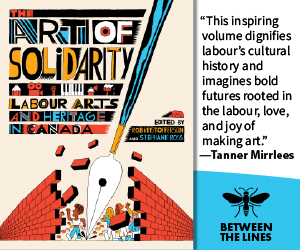Resisting education cuts in Alberta: Drawing on recent historical examples
We must see the fight against austerity as part of a larger struggle demanding a widespread and sustained protest movement

Operation Solidarity rally at Empire Field in Vancouver, where over 40,000 citizens joined to protest the government of Bill Bennett, August 10, 1983. Photo by Dan Keeton/Simon Fraser University Pacific Tribune Collection.
Dramatic changes are coming to Alberta post-secondary education. On the advice of a report commissioned from management consulting firm McKinsey & Company, the United Conservative Party is seeking the “renewal” of the post-secondary education system in Alberta that will make students “job ready” for a future economy. What this means is nebulous, but in the short term it has resulted in substantial cuts. The 2020 UCP budget came with a six percent cut to post-secondary education. In real terms this entails tens of millions of dollars cut from university budgets. For example, the Kenney government cut the University of Alberta’s budget by $44 million in 2019-20, and an astounding $110 million was sliced from the 2020-21 budget.
At my own institution, the University of Calgary, the response to similar impending cuts has been a program of rapid adaption and evolution. Behind the optimistic language of the UofC’s newly coined “Unstoppable” and “Growth Through Focus” messaging is a certain degree of desperation about the oncoming onslaught of cuts and the uncertain funding relationship with a hostile provincial government. Calgary also proclaimed itself Canada’s “Entrepreneurial University,” a branding which may reflect a future where the provincial post-secondary grant does not exist, and institutions are largely self-funded.
This path is not inevitable. Austerity itself can be set aside under conditions of financial and social crisis. In 2007-08, the global economy teetered on the edge of crisis and austerity was set aside to save corporations who were “too big to fail.” More recently, the COVID-19 crisis also disrupted austerity as trillions of dollars were pumped into the global economy to offset the dislocations of the crisis. In the narrower Alberta example, our own cash-strapped provincial government recently injected nearly $5 billion into the beleaguered oil and gas industry as a “job creation tax cut” in a decidedly anti-austerity measure. Now is not the time for cutbacks to education in Alberta during a crisis in which social spending is a necessary antidote to the overwhelmingly negative economic fallout of the pandemic. But the UCP is unlikely to see this as a viable path forward for Alberta.
If austerity is to be fought, we might look at the recent history of labour and student organizing to identify some high points of resistance. History does not necessarily repeat itself, but it does provide lessons that point towards the possibility of alternatives and the belief that another way is possible, even if movements in the past failed to achieve it.
A first example is the British Columbia Solidarity Movement. In 1983 and 1984, a Bill Bennett-led Social Credit government introduced a sweeping array of austerity measures that threatened deep cuts to education, welfare, health, and other social services, as well as curbs on traditional collective bargaining, especially in the public sector. Early protests on the lawn of the provincial legislature in Victoria drew over 25,000 people. A massive resistance movement developed. Bryan D. Palmer’s account of the movement tracks how the established labour movement responded to a widespread restructuring of labour relations and social programs.
The BC Federation of Labour and the province’s powerful trade union movement soon displaced the feminists, community activists, and left-wing militants who initiated the mobilization. For months, protests and the threat of a never-to-be realized general strike dominated the politics and everyday life of British Columbia. A one-day work stoppage in Vancouver culminated in a rally of 100,000 people. The extra-parliamentary opposition of the Solidarity Movement that opposed Bennet’s legislative agenda shunted the New Democratic Party to the sidelines.
The protests were initiated by leftists and groups aligned with what today would be called diverse social movements, although the organized left was a far stronger presence in the early 1980s than it is today. Initial meetings and protests of the 1983 uprising in BC contained much discussion of the need to sustain a militant opposition. Many activists—who appreciated that organized workers represented an important constituency with the power to mobilize resistance in job actions that could escalate into a province-wide shutdown—were vocal in their calls to prepare for and organize a general strike. It was believed that a general strike would bolster demands to repeal the government’s legislated austerity package. This militant orientation always faced an uphill battle among the broad forces rallying against the SoCred agenda, with mainstream trade union leaders and their counterparts in the NDP reluctant to mount an all-out struggle. Palmer writes, “the labour bureaucrats and social democracy were united in their conception that mass mobilization had to be directed away from militant struggle and into the subdued politics of electoralism.”
Solidarity settled on a strategy of escalating strikes. Resisting the education cuts in the austerity package, BC teachers joined the movement and went on strike in early November 1983. The willingness of teachers to strike symbolized much for the Solidarity movement, bringing the focus to the public sector and the larger effect of Bennett’s austerity program. For a brief moment it hinted at the possibility that public and private sector unions could jointly resist Bennett’s legislative agenda. But a general strike was not to be. A symbolically sorry capitulation, in which International Woodworkers’ leader Jack Munro met with Bennett on his Kelowna patio and shook hands, ending the escalating labour strikes and the momentous Solidarity mobilization. The denouement was memorialized in Tom Wayman’s epic poem, “The Face of Jack Munro,” and in Munro’s blustering account, “Derailing the Solidarity Express,” in his autobiography, Union Jack.
In 1983, more than 25,000 people marched on the British Columbia legislature as part of Operation Solidarity. The protesters were resisting cuts implemented by Bill Bennett and his Social Credit government. Photo from Simon Fraser University Pacific Tribune Collection.
Ultimately, the trade union wing, Operation Solidarity, undercut the wider Solidarity Coalition. The trade union bureaucracy became increasingly fixated on avoiding an all-out class confrontation. Instead, it narrowed the fight to individual unions negotiating exemptions from the egregious provisions of a few key bills, abandoning the struggle against the wider legislative austerity package. The larger reasons that animated the founding of the Solidarity resistance were forestalled. As mainstream trade union leaders chose restraint over repeal of Bennett’s legislative agenda they revealed themselves as willing to accept accommodation. As a consequence, they won far less than they could have with a more vigorous stand and came away with very little restraint indeed.
A second example happened at Trent University in Peterborough, Ontario in the early 2000s. In this instance, faculty and students fought neoliberal incursions into the governance of the university through resistance to cost-cutting decisions of the university board of governors. The opposition centred around the administration’s plan to close Trent’s downtown campuses at Traill College and Peter Robison College. Trent was unique in that it was founded with the support of working-class people in Peterborough, who contributed materially to the funding that established the university in the 1960s; the downtown college campus system linked the university to the town, but the Trent administration deemed the colleges to be financially unviable. A documentary film titled Whose University Is It? chronicled the fight pitting students and faculty against the Trent administration. Was the university an institution that served students and the community and could it be administered through faculty governance, or was it governed more strongly by the financial demands of the marketplace?
The battle played out on two different and unequal fronts. The first was in the Ontario courts, where Trent professors challenged the decision of the board of governors to act without the approval of the university senate, essentially sidelining the faculty from university decisions. A split decision at that court was appealed to the Supreme Court of Ontario where the Trent administration was backed by Mike Harris’s Progressive Conservative government. In 2001, Trent professor Ian McLaughlin said “It’s not surprising the Harris government supported the Trent board in front of the Ontario court. To put all the power in the hands of the board may make narrowly corporate ‘common sense,’ but it violates every norm of academic common sense.”
The Supreme Court of Ontario would eventually side with the Trent administration. While the case was still before the courts, some Trent students took a more direct-action approach in their fight with Trent University. A group known as “The Trent Eight” occupied the offices of the university vice president. In an unprecedented act of coercion, the student protesters were dragged from the offices two days later. Police in full riot gear hauled them out in the dead of night and “The Eight” were subsequently criminally charged. The university administration did not acknowledge or concede to any demands. The heavy-handed response provided a stark lesson about the stakes for activists taking the route of direct action.
With the Ontario government, corporate Ontario, and eventually the courts on its side, the Trent administration had little reason to deviate from its plans and one of the two downtown university campuses was subsequently closed. A few years later, with a double cohort of students entering university classrooms upon the abolition of Grade 13 in Ontario, Trent had to rent a downtown Bible college at significant cost in order to accommodate students whose needs could have been at least partially met if Peter Robinson had not been sold for a pittance. More significantly, the defeat consolidated power in the hands in the board of governors and gave the administration license to view all university decisions as matters of financial governance. Faculty, students, and the Peterborough community were subordinated.
A final example that should be in any discussion is the 2012 Québec student strike. Jean Charest’s Liberal government announced a plan to dramatically raise post-secondary tuition in the province over a five-year span. A coalition of student unions organized walkouts that subsequently drew support from unions across Québec, including teachers and professors, and opposition party leaders.
The student strike, characterized by over 100 nights of boisterous street protest throughout the province, was the largest student demonstration in Canadian history. At the height of the strike in early May, 185,000 students were boycotting classes. The strike led to the resignation of Education Minister and Deputy Premier Line Beauchamp, who realized she could not bring the conflict under control. Beyond the numbers, which were impressive, the movement won symbolic victories and the hearts of Québecers who identified with the struggle, seeing the tuition battle as an assault on the social welfare state itself. The red square worn by protestors became a symbol of resistance that carried real power beyond the borders of Québec, tapping into a history of anti-imperialist and anti-capitalist struggle in the province.
While the Charest government negotiated with student leaders to delay the tuition increase pending future study, the province also moved to repress the street demonstrations that came to symbolize the movement. This was attempted through brute repression in the form of mass arrests and provocation of strikers in the streets, and through legislation. Bill 78, passed in May 2012, prohibited demonstrators from wearing masks as a way to repress street protests. Demonstrations swelled in response, culminating in a march on May 22 marking 100 days of the student strike during a week in which 400,000 people filled Montréal streets. Nearly 600 were arrested between Montréal and Québec City in what student leaders called “the largest act of civil disobedience in Canadian history.” Charest’s government backed down. Bill 78 was repealed at the end of the summer, and in September 2012 his government froze tuition before being defeated the same month by the Partis Québécois in a provincial election.
What can we learn from these three examples that might galvanize us in the struggle in Alberta and elsewhere?
First, solidarity between different constituencies is essential and should be fostered. The BC Solidarity Movement represented an incredible moment of potential to challenge and turn back a retrogressive legislative package. As the movement of opposition was coopted by a powerful and cautious labour bureaucracy, whose access to funds and organizers eased its capacity to displace militants and contain the mobilization, an uprising was brought to its knees. If BC’s Solidarity has a lesson for today, it is that scaling back protest and limiting resistance to the lowest common denominator is destined to sell any movement of opposition short.
Solidarity’s defeat, moreover, cast a pall of disillusionment and demoralization over progressive forces in the province for a decade and more. An all-out fight against austerity, taken to its logical conclusion will—even if not entirely successful in the end—always secure more in the way of concessions than a capitulation in mid-stream. Squandering the energies of those seeking a more permanent pushback has longstanding and deleterious consequences that far outweigh the costs of fighting to win. The reasons for avoiding militant actions, including well thought out and widespread job actions, including the strategic use of a general strike that has the backing of wide support among the trade union ranks, will always be numerous and convincing, but the results of avoiding them are predictably disappointing.
Second, the austerity agenda so central to corporate Canada is now resilient and relentless, even if it is at times overshadowed by moments of crisis like the current pandemic. It is buttressed by powerful supports in the state and in the judiciary. Governments and courts will sustain this austerity at every turn, and do what they can to curtail challenges from oppositional quarters. Fighting for post-secondary education, like all manner of past struggles, from abolition of slavery to votes for women and trade union entitlements, must never be constrained by restricting the fight to specific and legally-recognized channels. As Bryan D. Palmer wrote, “the labour movement has never yet won any lasting or important gains by going through the ‘proper channels’—after all that is not what they are created for.”
If we hope to resist austerity in the service of post-secondary education in Alberta, we must see the fight as part of a larger struggle demanding a widespread and sustained protest movement. The state of post-secondary education in Alberta is an issue of concern to all even as it is presented as a particularistic concern of the well-to-do. Our purpose should be to extend the rights of post-secondary education to all who want to avail themselves of its possibilities, and in doing so link arms with those whom university research and teaching can potentially benefit: Indigenous peoples, the poor and the dispossessed, racialized groups, women, the disabled, the unemployed, and workers, be they in private sector or public sector trade unions, or employed in unorganized and precarious work. Struggles of various kinds are inextricably linked to others, and understanding this by seeking solidarity in the face of austerity is a way to build a movement to resist.
Ted McCoy is a historian and an Associate Professor in the Sociology Department at the University of Calgary. He is on Twitter at @tedmccoy.










